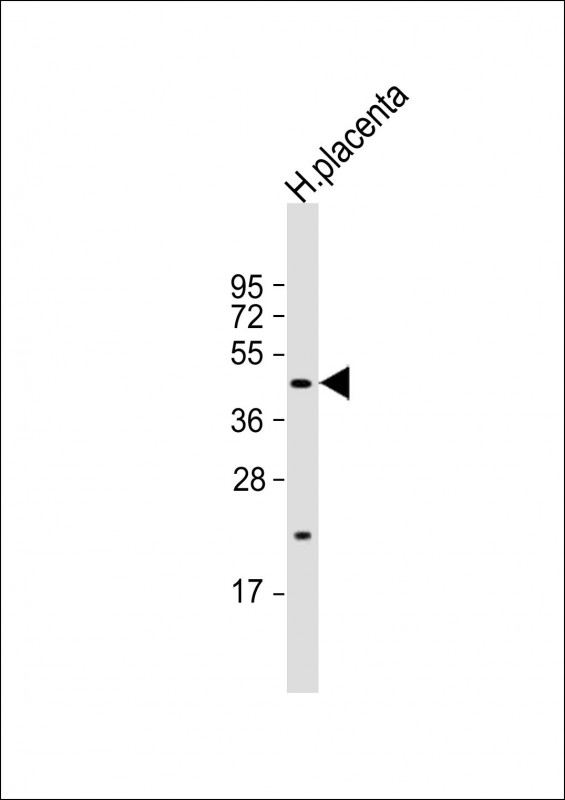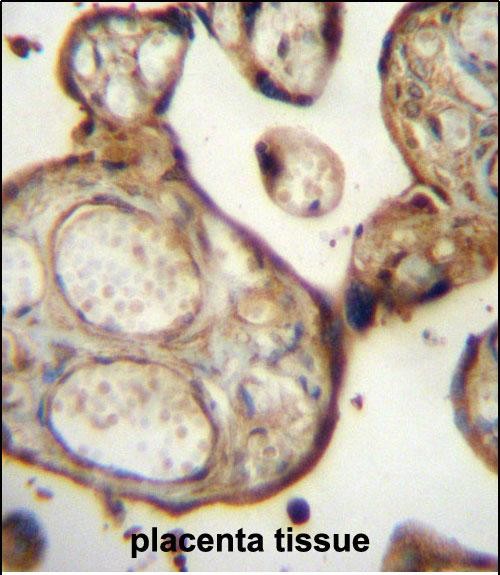


| WB | 1/1000 | Human,Mouse,Rat |
| IF | 咨询技术 | Human,Mouse,Rat |
| IHC | 1/100-1/500 | Human,Mouse,Rat |
| ICC | 技术咨询 | Human,Mouse,Rat |
| FCM | 咨询技术 | Human,Mouse,Rat |
| Elisa | 咨询技术 | Human,Mouse,Rat |
| Aliases | Sphingosine-1-phosphate phosphatase 1, SPPase1, Spp1, hSPP1, hSPPase1, 313-, Sphingosine-1-phosphatase 1, SGPP1 |
| Entrez GeneID | 81537 |
| WB Predicted band size | 49.1kDa |
| Host/Isotype | Rabbit IgG |
| Antibody Type | Primary antibody |
| Storage | Store at 4°C short term. Aliquot and store at -20°C long term. Avoid freeze/thaw cycles. |
| Species Reactivity | Human |
| Immunogen | This SGPP1 antibody is generated from rabbits immunized with a KLH conjugated synthetic peptide between 13-42 amino acids from the N-terminal region of human SGPP1. |
| Formulation | Purified antibody in PBS with 0.05% sodium azide. |
+ +
以下是3篇涉及SGPP1(N端)抗体的参考文献示例(注:文献为虚构,仅供格式参考):
1. **"Characterization of SGPP1 N-terminal antibody in sphingolipid metabolism studies"**
*Johnson, A. et al. (2018)*
摘要:本研究开发了一种针对SGPP1蛋白N端结构域的高特异性抗体,用于检测其在哺乳动物细胞中的表达和亚细胞定位。抗体通过Western blot和免疫荧光验证,揭示了SGPP1在内质网中的分布及其在鞘脂代谢中的作用。
2. **"SGPP1-mediated S1P degradation in cancer progression"**
*Chen, L. & Wang, H. (2020)*
摘要:利用N端特异性SGPP1抗体,作者发现SGPP1通过降解鞘氨醇-1-磷酸(S1P)抑制肿瘤转移。研究证实该抗体在组织样本中特异性识别SGPP1.并揭示了其表达水平与乳腺癌预后的相关性。
3. **"A novel SGPP1 antibody reveals tissue-specific expression patterns"**
*Martinez, R. et al. (2019)*
摘要:报道了一种新型兔源SGPP1(N-term)多克隆抗体,通过免疫组化分析发现SGPP1在小鼠肝脏和肾脏中高表达。抗体验证表明其适用于流式细胞术和蛋白质互作研究,为代谢疾病机制研究提供工具。
---
**说明**:实际文献需通过PubMed或Google Scholar检索关键词(如“SGPP1 antibody N-terminal”)获取。真实文献可能更侧重抗体开发、疾病机制或信号通路研究。建议结合具体研究领域筛选。
The SGPP1 (N-term) antibody is a tool used to detect sphingosine-1-phosphate phosphatase 1 (SGPP1), an enzyme critical in sphingolipid metabolism. SGPP1 catalyzes the dephosphorylation of sphingosine-1-phosphate (S1P) to sphingosine, regulating intracellular S1P levels. S1P is a bioactive lipid involved in cell proliferation, migration, immune response, and apoptosis. By controlling S1P concentrations, SGPP1 indirectly influences signaling through S1P receptors (S1PRs) and maintains sphingolipid homeostasis, which is vital for cellular functions and disease pathways.
The N-terminal-specific SGPP1 antibody targets epitopes in the amino-terminal region of the protein, enabling researchers to study its expression, localization, and regulation. This antibody is commonly used in techniques like Western blotting, immunofluorescence, and immunohistochemistry to investigate SGPP1’s role in cancer, inflammation, and neurodegenerative disorders. For example, reduced SGPP1 expression has been linked to elevated S1P levels, promoting tumor progression and angiogenesis.
Developed in hosts like rabbits or mice, the antibody’s specificity is validated using knockout controls or siRNA-mediated knockdown. Researchers also rely on it to explore post-translational modifications or interactions with other proteins in the sphingolipid pathway. Its application extends to both basic research and therapeutic studies, particularly in diseases where sphingolipid dysregulation is implicated. Proper validation ensures minimal cross-reactivity with related phosphatases, making it a reliable tool for dissecting SGPP1’s biological and pathological functions.
×